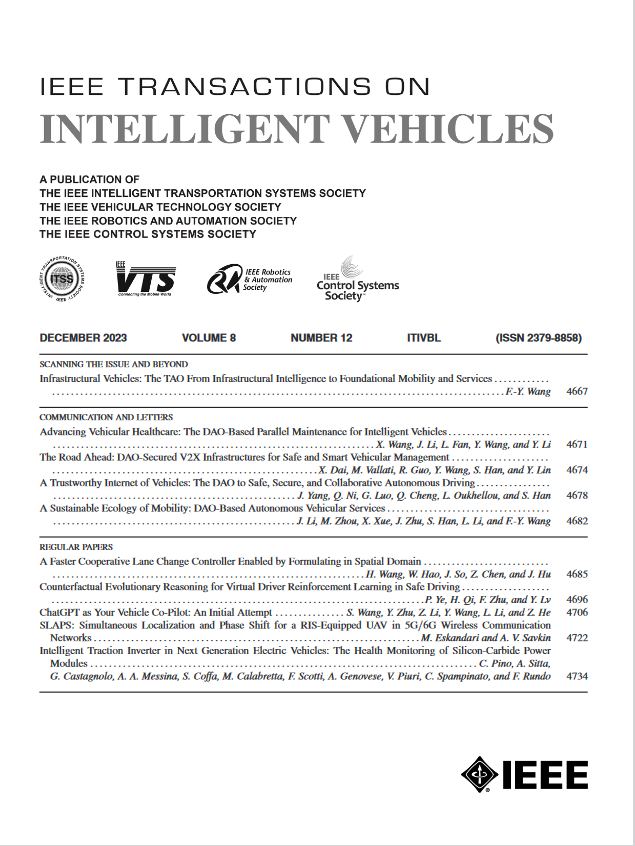Vehicle Braking Stability Control With Variable Ratio Braking Forces Optimization Distribution During Cornering Braking Process
IF 14
1区 工程技术
Q1 COMPUTER SCIENCE, ARTIFICIAL INTELLIGENCE
引用次数: 0
Abstract
During the vehicle cornering braking process, there is a complex coupling relationship between the longitudinal and lateral forces, and the auxiliary steering and braking systems are usually coordinated to achieve the vehicle braking stability and the lane keeping simultaneously. However, the auxiliary steering angle may change the trajectory of the vehicle. In order to simplify the control process and enhance the braking stability, a braking stability control strategy without the auxiliary steering system is proposed based on an adaptive sliding mode control algorithm with optimized braking forces distribution. The distribution ratio of the front and rear braking forces is optimized by considering the various braking strengths and compliance with ECE regulations. The adaptive sliding mode control algorithm is designed to obtain the additional yaw moment to control the steering process. A new convergence law is developed based on a constant rate convergence law and a power rate convergence law to accelerate the convergence process. The ultimate braking forces of each wheel are formed with the optimized front and rear braking forces and the additional braking forces obtained based on the steering characteristics of the vehicle and the additional yaw moment. Finally, the strategy's effectiveness and superiority are validated and compared with the fixed ratio strategy through hardware-in-loop experiments. The results demonstrate that the vehicle braking stability control strategy achieves smaller tracking errors for yaw rate and sideslip angle, reduced fluctuation in the sideslip angle curve, a smaller lateral deviation, a smaller phase plane trajectory area, and improved stability.变比制动力优化分配的车辆转弯制动稳定性控制
在车辆转弯制动过程中,纵向力和横向力之间存在复杂的耦合关系,辅助转向系统和辅助制动系统通常需要协同工作,以同时实现车辆的制动稳定性和车道保持。然而,辅助转向角度可能会改变车辆的轨迹。为了简化控制过程,提高制动稳定性,提出了一种基于优化制动力分配的自适应滑模控制算法的无辅助转向系统制动稳定性控制策略。在考虑各种制动强度和符合ECE规定的前提下,优化了前后制动力的分配比例。设计了自适应滑模控制算法,以获取附加偏航力矩来控制转向过程。在恒速收敛律和幂速收敛律的基础上,提出了一种新的收敛律,以加快收敛过程。根据车辆转向特性和附加偏航力矩得到优化后的前后制动力和附加制动力,形成各车轮的极限制动力。最后,通过硬件在环实验验证了该策略的有效性和优越性,并与固定比率策略进行了比较。结果表明,该制动稳定性控制策略实现了较小的横摆角速度和侧滑角跟踪误差,减小了侧滑角曲线波动,减小了横向偏差,减小了相平面轨迹面积,提高了稳定性。
本文章由计算机程序翻译,如有差异,请以英文原文为准。
求助全文
约1分钟内获得全文
求助全文
来源期刊

IEEE Transactions on Intelligent Vehicles
Mathematics-Control and Optimization
CiteScore
12.10
自引率
13.40%
发文量
177
期刊介绍:
The IEEE Transactions on Intelligent Vehicles (T-IV) is a premier platform for publishing peer-reviewed articles that present innovative research concepts, application results, significant theoretical findings, and application case studies in the field of intelligent vehicles. With a particular emphasis on automated vehicles within roadway environments, T-IV aims to raise awareness of pressing research and application challenges.
Our focus is on providing critical information to the intelligent vehicle community, serving as a dissemination vehicle for IEEE ITS Society members and others interested in learning about the state-of-the-art developments and progress in research and applications related to intelligent vehicles. Join us in advancing knowledge and innovation in this dynamic field.
 求助内容:
求助内容: 应助结果提醒方式:
应助结果提醒方式:


